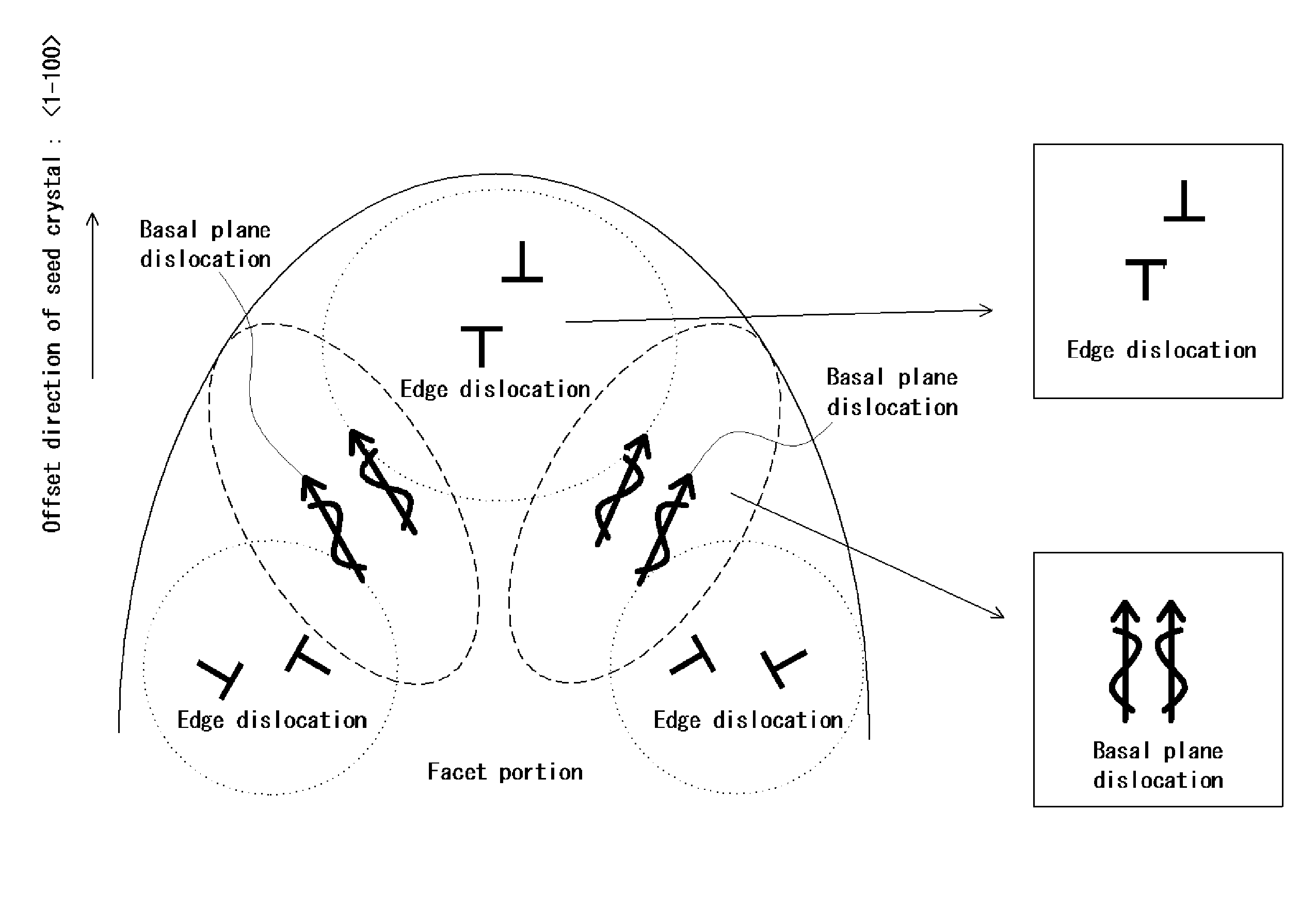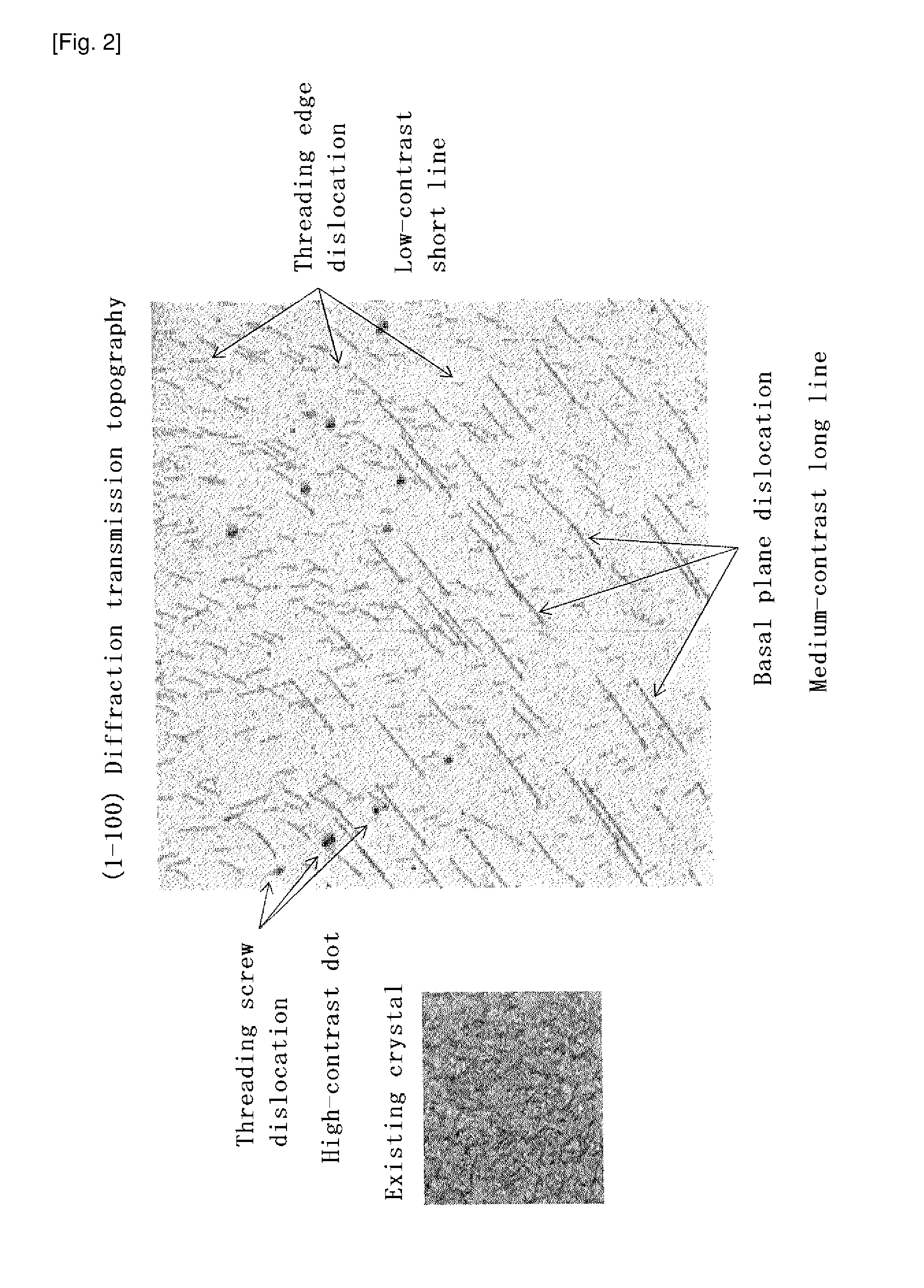Sic single crystal, sic wafer, sic substrate, and sic device
a technology of sic wafers and substrates, applied in the direction of crystal growth process, polycrystalline material growth, chemically reactive gases, etc., can solve the problem of difficult to convert parallel to an offset direction of the substrate into edge dislocations, affecting device characteristics, etc., to and suppress the degradation of characteristics due to a specific dislocation type
- Summary
- Abstract
- Description
- Claims
- Application Information
AI Technical Summary
Benefits of technology
Problems solved by technology
Method used
Image
Examples
example
Example 1
[0134]A seed crystal for c-plane growth, of which the offset direction was a direction, was cut from a crystal that was formed by repeating a-plane growth five times while a growth direction was changed. Subsequently, the surface of the seed crystal was processed such that a growth plane was configured of three planes, and an angle defined by a ridge line between the planes and a {0001} plane was 2.7 degrees.
[0135]Furthermore, a screw dislocation formable region that allowed formation of a screw dislocation was formed near an intersection between the three planes.
[0136]A SiC single crystal was grown by the sublimation-reprecipitation process using the resultant seed crystal. The growth was performed while a highest point of the {0001} plane, which was formed by the three planes within the screw dislocation formable region, was disposed close to the center of a crucible such that the neighborhood of the highest point of the {0001} plane was maintained a...
example 2
[0168]A seed crystal for c-plane growth, of which the offset direction was a direction, was cut from a crystal that was formed by repeating a-plane growth five times while a growth direction was changed. Subsequently, a surface of the seed crystal was processed such that a growth plane was configured of three planes, and an angle defined by a ridge line between the planes and a {0001} plane was 2.7 degrees.
[0169]Furthermore, a screw dislocation formable region that allowed formation of a screw dislocation was formed near an intersection between the three planes.
[0170]A SiC single crystal was grown by the sublimation-reprecipitation process using the resultant seed crystal. The growth was performed while a highest point of a {0001} plane, which was formed by the three planes within the screw dislocation formable region, was disposed close to the center of a crucible such that the neighborhood of the highest point of the {0001} plane was maintained at lowest temp...
example 3
[0172]A seed crystal for onset c-plane growth (the seed crystal had an onset bottom face) was cut from a crystal that was formed by repeating a-plane growth five times while a growth direction was changed. Subsequently, a surface of the seed crystal was processed such that a growth plane was configured of three planes, and an angle defined by a ridge line between the planes and a {0001} plane was 2.7 degrees. Furthermore, a screw dislocation formable region that allowed formation of a screw dislocation was formed near an intersection between the three planes.
[0173]A SiC single crystal was grown by the sublimation-reprecipitation process using the resultant seed crystal. In growth using an onset substrate, size of a facet is particularly easily increased during growth. Thus, to suppress this, the growth was performed while a site (near the center) of a seed-crystal holding base, which corresponded to the neighborhood of a highest point of the {0001} plane formed ...
PUM
 Login to View More
Login to View More Abstract
Description
Claims
Application Information
 Login to View More
Login to View More - R&D Engineer
- R&D Manager
- IP Professional
- Industry Leading Data Capabilities
- Powerful AI technology
- Patent DNA Extraction
Browse by: Latest US Patents, China's latest patents, Technical Efficacy Thesaurus, Application Domain, Technology Topic, Popular Technical Reports.
© 2024 PatSnap. All rights reserved.Legal|Privacy policy|Modern Slavery Act Transparency Statement|Sitemap|About US| Contact US: help@patsnap.com










